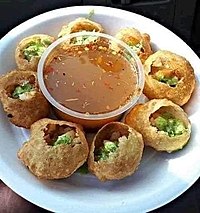Indian cuisine consists of a variety of regional and traditional cuisines native to the Indian subcontinent. Given the diversity in soil, climate, culture, ethnic groups, and occupations, these cuisines vary substantially and use locally available spices, herbs, vegetables, and fruits.

Pakistani cuisine can be characterized as a blend of regional cooking styles and flavours from across South, Central and Western Asia. Pakistani cuisine is influenced by Persian, Indian, and Arab cuisine. The cuisine of Pakistan also maintains certain Mughal influences within its recipes and cooking techniques. Pakistan's ethnic and cultural diversity, diverse climates, geographical environments, and availability of different produce lead to diverse regional cuisines.

Bhelpuri is a savoury snack originally from India, and is also a type of chaat. It is made of puffed rice, vegetables and a tangy tamarind sauce, and has a crunchy texture.

Chaat, or chāt is a family of savoury snacks that originated in India, typically served as an hors d'oeuvre or at roadside tracks from stalls or food carts across South Asia in India, Pakistan, Nepal and Bangladesh. With its origins in Uttar Pradesh, India, chaat has become immensely popular in the rest of South Asia.

Puri, also poori, is a type of deep-fried bread, made from unleavened whole-wheat flour, originated from the Indian subcontinent.
Maharashtrian or Marathicuisine is the cuisine of the Marathi people from the Indian state of Maharashtra. It has distinctive attributes, while sharing much with other Indian cuisines. Traditionally, Maharashtrians have considered their food to be more austere than others.
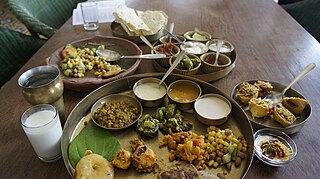
Gujarati cuisine is the cuisine of the Indian state of Gujarat. The typical Gujarati thali consists of rotli, dal or curry, rice, and shaak. The thali will also include preparations made from pulses or whole beans such as moong, black eyed beans etc., a snack item (farsaan) like dhokla, pathra, samosa, fafda, etc. and a sweet (mishthaan) like mohanthal, jalebi, sevaiya etc.

Dahi puri is an Indian snack food which is especially popular in the state of Maharashtra. The dish is a type of chaat and originates from the city of Mumbai. It is served with mini-puri shells (golgappa), which are also used for the dish pani puri. Dahi puri and pani puri chaats are often sold by the same vendor.
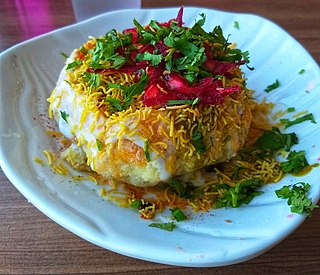
Kachori is a deep-fried, spicy, stuffed pastry originating from the Marwar region of Rajasthan, India. It is made of maida filled with a stuffing of baked mixture of moong dal or onions, besan, coriander, red chili powder, salt, and other Indian spices and deep-fried in vegetable oil until crispy golden brown. It is served hot with sweet and spicy tamarind chutney or occasionally with mint and green chilli chutney.
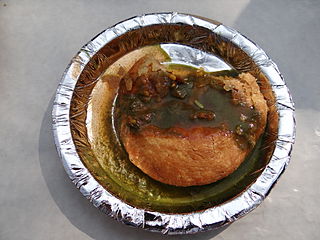
Kanda Kachori or Pyaaz Kachori is a crispy, flaky, deep-fried pastry filled with spiced onion stuffing. It is typically served hot with a sweet and spicy tamarind chutney. Originating in the city of Jodhpur, pyaaz kachori is now enjoyed throughout Rajasthan and North India.
Bhojpuri cuisine is a style of food preparation common among the Bhojpuri people of Bihar and eastern Uttar Pradesh in India, and also the Terai region of Nepal. Bhojpuri foods are mostly mild and tend to be less hot in terms of spices used. The cuisine consists of both vegetable and meat dishes.

Chole bhature is a food dish popular in the northern areas of the Indian subcontinent. It is a combination of chana masala and bhatura/puri, a deep-fried bread made from maida.
Awadhi cuisine is a cuisine native to the Awadh region in Northern India and Southern Nepal. The cooking patterns of Lucknow are similar to those of Central Asia, the Middle East, and Northern India and western India with the cuisine comprising both vegetarian and non-vegetarian dishes. The Awadh region has been influenced by Mughal cooking techniques, and the cuisine of Lucknow bears similarities to those of Central Asia, Kashmir, Punjab and Hyderabad. The city is also known for its Nawabi foods.

Andhra cuisine, culturally known as Telugu cuisine, is a cuisine of India native to the state of Andhra Pradesh and is the culinary style of Telugu people. It is generally known for its tangy, hot, and spicy taste.
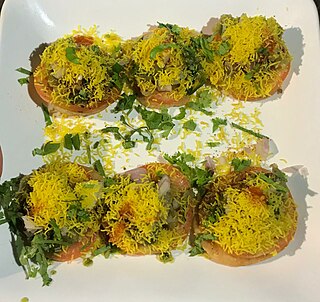
Sev puri is an Indian snack and a type of chaat. It is a speciality that originates from Mumbai, Maharashtra, India. In Pune and Mumbai, sev puri is strongly associated with street food, but is also served at upscale locations. Recently, supermarkets have started stocking ready-to-eat packets of sev puri and similar snacks like bhelpuri.

Puri bhaji is a dish, originating from the Indian subcontinent, of puri and aloo (potato) bhaji. It is a traditional breakfast dish in North India.
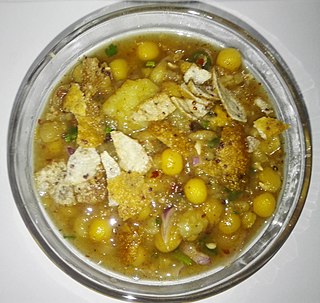
Chotpoti, is a Bengali street food popular in Bangladesh and West Bengal, India, mostly in urban areas. The word 'chotpoti' translates to 'spicy'.

Alu chat is a street food originating from the Indian subcontinent, it is popular in North India, West Bengal in Eastern India, Pakistan and also in parts of Sylhet Division of Bangladesh. It is prepared by frying potatoes in oil and adding spices and chutney. It can also be prepared with unfried boiled potatoes and also adding fruits along with spices, lime juice and chutney.

Masala puri, or Masalpuri, is an Indian snack which is especially popular in the southern state of Karnataka. A form of chaat, the dish originated in the Indian state of Mysore and has now become famous in the entire Indian subcontinent. Typically spicy, the dish can also be made sweet based on the requirement.
